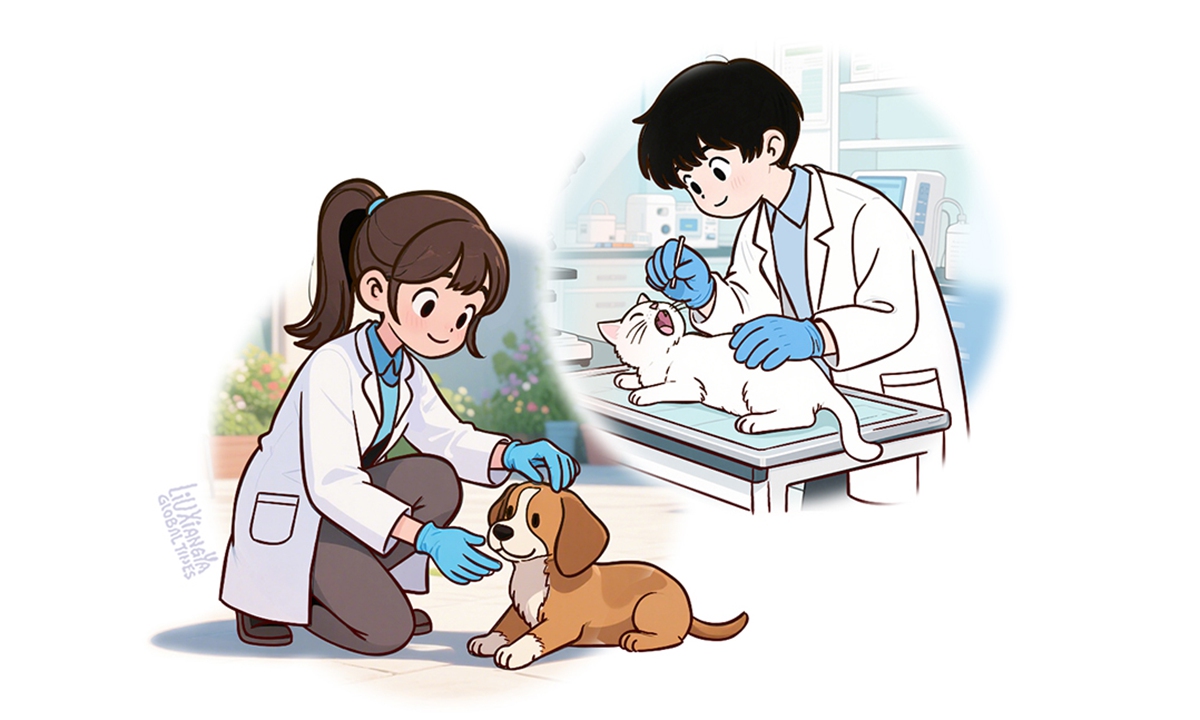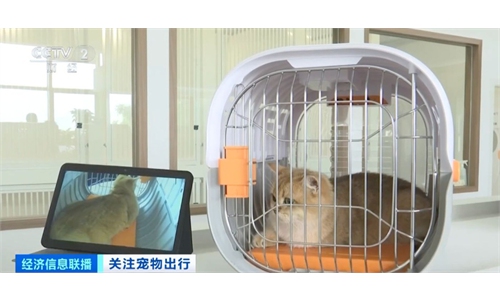ARTS / CULTURE & LEISURE
New pet major shows university’s pragmatic spirit

Illustration: Liu Xiangya/GT
An undergraduate major dedicated to pets was recently launched at China Agricultural University (CAU), the first such major ever offered in China. The new major might make one wonder why a university would see the need to cultivate pet talents. Yet, its establishment shows how Chinese higher education has evolved to resonate with emerging social trends and industry demands.The new major is housed within CAU's College of Animal Science and Technology. Instead of calling them "pets," the college officially uses the term "companion animals" to describe the major's focus.
Using this terminology is not just about making the discipline sound more formal, but also reveals the major's dedication to optimizing the "companionship" between people and animals. This is also the reason why the course includes subjects such as "canine and feline behavior studies" as well as "nutrition science of companion animals."
Focusing on human-pet interaction, the new major inevitably leads people to think how extensive our passion is for our "furry kids." It is strikingly clear - raising pets is a trending choice in China.
Take 2024 as an example. That year, China's urban and county-level pet consumption market, particularly for dogs and cats, surpassed 300 billion yuan ($41.8 billion). Additionally, the annual average spending per pet reached 2,961 yuan for dogs and 2,020 yuan for cats.
These figures reflect the massive consumption demand in the pet industry. There are also numerous opportunities to be had for the employment of young talents or for propelling the "it economy," also known as the "pet economy."
Higher education institutions must develop talents to meet society's evolving needs. In this light, the establishment of a "pet" major shows Chinese universities are walking out from their "ivory tower" to use an emerging social trend as a benchmark for cultivating industry professionals. This essentially demonstrates the pragmatic spirit of the Chinese higher education system.
Meanwhile, this niche "pet" major shows the alignment of China's animal husbandry with global academic standards. Similar majors can commonly be found in countries such as the US and Canada at institutions like the University of Alberta.
The university's launch of an undergraduate major focusing on companion animals is truly energizing for the industry, said Liu Xiaoxia, an official with the Pet Industry Branch of the China Animal Agriculture Association.
Beyond cultivating industry-ready talents, the university's new major can also reshape the public's perception toward careers in this particular sector.
Traditionally, pet-related workers such as pet groomers were often perceived as "technicians" who, in many people's eyes, received vocational training at secondary educational-level schools such as vocational high school. However, as CAU is one of China's "Double First-Class" universities, the establishment of this program enables students to earn the solid title of a "top-tier institution graduate."
On one hand, such an elevated educational background can significantly enhance these talents' career prospects; on the other hand, it compels the public to recognize the "pet" discipline as a legitimate academic field on par with traditional professions such as the medical or engineering fields.
Higher-education institutions can provide students not just good qualifications, but also hands-on practical opportunities. For instance, the first 50 students enrolled in the new pet major will gain access to collaboration opportunities with industry associations and NGOs during their studies.
Against this backdrop, more young talents will inevitably be drawn to this discipline. Related industries, in turn, will thrive with this growing talent pool, and form a healthy development cycle. In other words, those once seen as "secondary school graduates" will likely become sought-after candidates valued by both schools and the industry.
While this newly founded pet major reflects the bond between academia and industry, it ultimately mirrors Chinese society's emerging social atmosphere for embracing pets as well as the changing cultural role of pets going from being "watchdogs" to "fur kids."
In the past, pets like dogs and cats were primarily defined by utilitarian functions such as home guardians or mouse catchers. But today, they are treated more commonly as a family member who is able to affectionately interact with owners. This is also the reason why pets are described as "kids" by many.
The shift from "watchdog" to "fur kid" does not just show how people are changing due to the developments of society (including their reactions to urban life, attitudes toward fertility, family structure and consumption), but more profoundly, reveals a civilized Chinese social paradigm: Respecting the coexistence between humans and other living beings.
Following this paradigm shift, besides new university majors, many other pet-inclusive programs have been implemented as nationwide policy. For example, China's railway department has expanded the scope of its pilot program for pet transportation services on high-speed railways, including eight major routes such as Beijing-Shanghai and Shanghai-Kunming.
Pet-inclusive policies like this one show society's compassion and warmth. However, this inclusivity is not one-sided. It requires shared responsibility and compliance, including for example, pet owners' adherence to regulations.
"No one can resist the innate cuteness of pets. Everyone loves a fur baby that has been trained well," Yao Hongxiao, a 63-year-old pet keeper, told the Global Times.
The author is a reporter with the Global Times. life@globaltimes.com.cn



